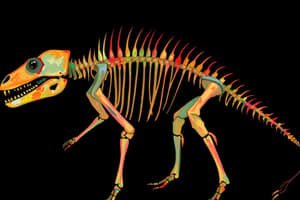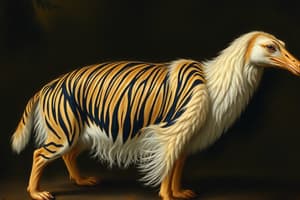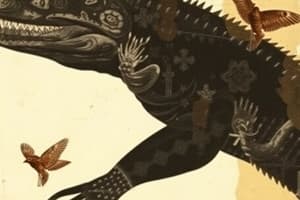Podcast
Questions and Answers
Which feature is NOT considered a shared derived characteristic of chordates?
Which feature is NOT considered a shared derived characteristic of chordates?
- Postanal tail
- Chitinous exoskeleton (correct)
- Notochord
- Neural tube
Which group is considered the closest sister group to chordates?
Which group is considered the closest sister group to chordates?
- Cyclostomata
- Echinoderms
- Hemichordates (correct)
- Gnathostomata
What is the function of the endostyle in chordates?
What is the function of the endostyle in chordates?
- Assists in filter feeding and takes up iodine (correct)
- Aids in circulation and nutrient transport
- Provides structural support to the head
- Vision and light sensitivity
Which of these features is an ancestral characteristic of deuterostomes?
Which of these features is an ancestral characteristic of deuterostomes?
In lancelets, the notochord serves which primary function?
In lancelets, the notochord serves which primary function?
Which of the following features is NOT a synapomorphy for all chordates?
Which of the following features is NOT a synapomorphy for all chordates?
What structural role does the neural tube perform in chordates?
What structural role does the neural tube perform in chordates?
Which of the following groups includes a feature that extends beyond the nerve cord?
Which of the following groups includes a feature that extends beyond the nerve cord?
Which of the following is true regarding pharyngeal slits in chordates?
Which of the following is true regarding pharyngeal slits in chordates?
In the context of chordate anatomy, myomeres are primarily responsible for what?
In the context of chordate anatomy, myomeres are primarily responsible for what?
Flashcards
Vertebrates and Chordates
Vertebrates and Chordates
Vertebrates are a group of animals within the Chordata phylum. Chordates share common features like notochord, neural tube, postanal tail, and endostyle.
Notochord
Notochord
A flexible rod-like structure that provides support in chordate embryos and some adults. It's crucial for skeletal support and muscle attachment.
Neural Tube
Neural Tube
A hollow tube that forms the central nervous system in chordates. It's located dorsally (the back).
Postanal Tail
Postanal Tail
Signup and view all the flashcards
Endostyle
Endostyle
Signup and view all the flashcards
Deuterostomes
Deuterostomes
Signup and view all the flashcards
Hemichordates
Hemichordates
Signup and view all the flashcards
Pharyngeal slits
Pharyngeal slits
Signup and view all the flashcards
Cephalochordata (Lancelets)
Cephalochordata (Lancelets)
Signup and view all the flashcards
Urochordata (Tunicates)
Urochordata (Tunicates)
Signup and view all the flashcards
Study Notes
Vertebrate Classification
- Vertebrates are chordates, along with tunicates and lancelets.
- Chordates are deuterostomes, alongside hemichordates and echinoderms.
- Hemichordates were once considered the closest relatives of chordates.
- Both chordates and hemichordates share a pharynx with pharyngeal slits.
- Pharyngeal slits are now seen as an ancestral feature of deuterostomes.
Chordate Characteristics
- All chordates share four key derived features (synapomorphies):
- Notochord: A stiffening rod for muscle attachment.
- Neural tube: A dorsal hollow nerve cord coordinating muscle activities.
- Post-anal tail: Provides propulsion from myomeres (segmented muscles).
- Endostyle: A ciliated, glandular groove in the pharynx aiding in filter feeding and iodine uptake.
Chordate Examples
- Cephalochordata (Lancelets)
- Urochordata (Tunicates)
- Vertebrata
- Cyclostomata
- Gnathostomata
Lancelet Anatomy (Key Features)
- Notochord: A stiffening rod extending beyond the nerve cord.
- Neural tube: A dorsal hollow nerve cord.
- Post-anal tail: Segmented muscles (myomeres) for propulsion.
- Endostyle: A ciliated, glandular groove on the pharynx floor.
Studying That Suits You
Use AI to generate personalized quizzes and flashcards to suit your learning preferences.




